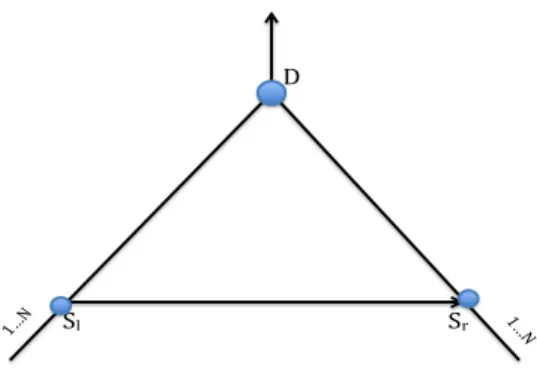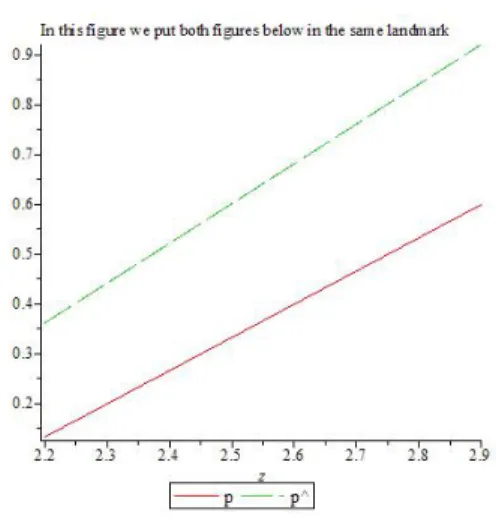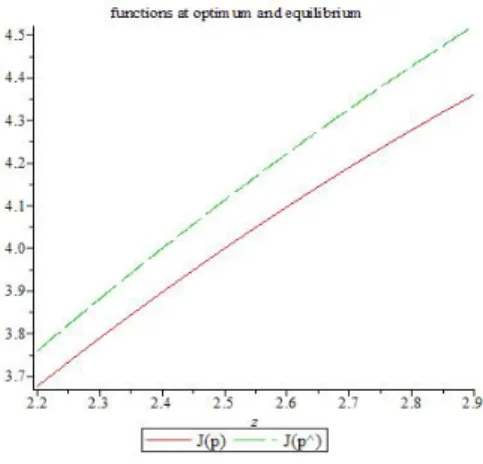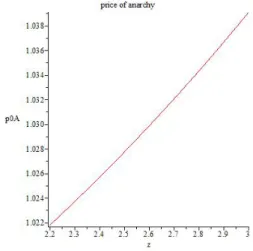HAL Id: hal-01535718
https://hal.inria.fr/hal-01535718
Submitted on 9 Jun 2017
HAL is a multi-disciplinary open access
archive for the deposit and dissemination of
sci-entific research documents, whether they are
pub-lished or not. The documents may come from
teaching and research institutions in France or
abroad, or from public or private research centers.
L’archive ouverte pluridisciplinaire HAL, est
destinée au dépôt et à la diffusion de documents
scientifiques de niveau recherche, publiés ou non,
émanant des établissements d’enseignement et de
recherche français ou étrangers, des laboratoires
publics ou privés.
Paradoxes in a Multi-criteria Routing Game
Amina Boukoftane, Eitan Altman, Majed Haddad, Nadia Oukid
To cite this version:
Amina Boukoftane, Eitan Altman, Majed Haddad, Nadia Oukid. Paradoxes in a Multi-criteria
Rout-ing Game. 7th EAI International Conference on Game Theory for Networks, May 2017, Knoxville,
Tennessee, United States. �hal-01535718�
Amina Boukoftane1, Eitan Altman2,3, Majed Haddad4, and Nadia Oukid1
University of Blida 1, Route de Soumaa, B.P. 270, Blida, Algeria1 Universit Cote d’Azur (UCA), INRIA, 06902 Sophia-Antipolis, France2
LINCS, 23 avenue d’Italie, 75013 Paris, France3
LIA/CERI, University of Avignon, Agroparc, BP 1228, 84911, Avignon, France4
Abstract. In this paper, we consider a routing game in a network that contains lossy links. We consider a multi-objective problem where the players have each a weighted sum of a delay cost and a cost for losses. We compute the equilibrium and optimal solution (which are unique). We discover here in addition to the classical Kameda type paradox another paradoxical behavior in which higher loss rates have a positive impact on delay and therefore higher quality links may cause a worse performance even in the case of a single player.
Keywords: Routing game, multi-objective problem, lossy links, Nash equilibrium, price of anarchy, paradox.
1
Introduction
There has been much work on routing games with additive costs (cost associated with a route is additive over the links of the route) [6,7]. This has been extended to multi-objective additive criteria, see e.g., [4,8,6]. Little is known however on routing games with non additive costs. There has been some work on routing games for some given simple topologies with non-additive costs [6] triggered by networking applications (e.g., [5,3]).
In this work, we consider costs related to weighted sum of two different types of performances: the delay which is additive, and losses which are not. We focus on a simple network model that has been studied in the case of a single objective by [2,3]. We first derive explicit expression of the equilibrium and then study numerically its properties.
In case of a single objective, it has been shown that a Braess type paradox exists for the topology that we consider [2,3]. We identify a new type of paradox which has some surprising behavior. We then compute the price of anarchy (defined as in [1]).
The rest of the paper is organized as follows: In Section 2, we describe the system model and the performance measures adopted throughout the paper. In Section 3, we compute the global optimum. The Nash equilibrium is computed in Section 4. Simulation results along with the discussion are presented in Section 6. Performance results including the price of anarchy and paradoxes are provided in 5. Section 7 concludes the paper.
2 1…N 1…N D Sl Sr
Fig. 1. The competitive routing model.
2
The model and performance measures
We shall use the load balancing network topology introduced in [2] consisting of three nodes: two source nodes Sr and Sl (r stands for right and l for left) and one common destination node D (see Figure 1). There are 2N sources of flows, S(i), i = 1, . . . , 2N . Each flow consists of an independent Poisson distributed point process with a rate φ. Packets from source i = 1, . . . , N arrive packets from source i = N + 1, . . . , 2N arrive at node Sr(right). Source i = 1, . . . , N can split its flow between its direct path SlD and the indirect one SlSrD. Source i = N + 1, . . . , 2N can split its flow between its direct path SrD and the indirect one SrSlD.
More precisely, whenever a packet arrives from source i, the source flips a coin that has a probability pito have an outcome called ”direct” and a probability of 1 − pi to have an outcome called ”indirect”. If the outcome is ”direct” then the packet is routed over the direct route, and otherwise it is routed over the indirect one. The process of packets originating from source i that take the direct path is thus Poisson with rate φpi. The process of packets that arrive at node i and that take the indirect path is Poisson with rate φ(1 − pi). Let xil be the rate of flow sent by source i through link l. Links SrSl and SlSr are assumed to be wireless so that packets sent over SrSl and SlSr suffer independent losses with some fix probability q. The delay over these links is assumed to be a constant denoted by δ. Links SlD and SrD are assumed to be lossless but they incur a congestion cost per flow unit that uses them of Tl(x) = 1/(C − xl). Here, C is the link capacity and xlis the total flow going through link l. Therefore for each player i, consider the arrival process of packets that arrive at node Sk and that are rerouted to the indirect path SkSmD (where k = l, r, m 6= k). It is a Poisson process as well and its rate is φp(1 − pi)(1 − q).
Let i ≤ N . The cost for source i is a weighted sum of the average delay of its flow and its loss rate:
Ji(p) = φpi C − φPNj=1pj− φqP2Ni=N +1(1 − pj)+ φ(1 − q)(1 − pi) C − φP2Nj=N +1pj− φq PN i=1(1 − pj) + φδ(1 − q)(1 − pi) + γφq(1 − pi). (1)
The three first terms correspond to the delay cost and the last term corre-sponds to the cost of losses. The first term correcorre-sponds to the congestion cost in the direct path of i and the two following terms correspond to the conges-tion cost along the indirect path. The optimal symmetric soluconges-tion is obtained by minimizing P
iJi(p) over pi and adding the constraint that pi are the same for all i (we then omit i from the notation pi).
Let Xl(x) = φ N X j=1 pj+ φq 2N X j=N +1 (1 − pj)
be the rate of packets that use link SlD. We assume that the link cost per unit of flow are linear in the flow through them. This amounts to use the first term in the Taylor’s expansion of (1). Ji(p) is thus approximated by
Ji(p) =
φpi(axl+ b) + φ(1 − q)(1 − pi)(axl+ b) + δφ(1 − pi) + γφq(1 − pi) where a and b are some positive constants.
3
Global optimum calculation
The global optimal solution is obtained by solving
∂ ∂p 2N X i=1 Ji(p) = 0
(unless it is on the boundary). We obtain the unique solution:
p = 1 2
aφN (2q2− 2q + 1) + bq − γq − δ φaqN (q − 1) .
We find it convenient in the numerical investigation to write z = γq + δ since the dependence of the global optimum or the equilibrium on each one of the two parameters δ and γ (for fixed q) appears only through the value of z. Thus, p can be written:
4 p = 1 2 aφN (2q2− 2q + 1) + bq − z φaqN (q − 1) . Note that J0(p) = 2aφ2q2N (1 − p) + φbq + φ2aN + 2aφ2qN (p − 1) − φz. J0(p) = 0 for z = −2aφqN (((1 − p)(1 − q)) + bq + aφN
J0(p) is positive if z < φaN (2q(q − 1)(1 − p) + 1) + qb. In this case J is an increasing function , and the minimum is reached on 0.
On the other hand, if z > φaN (2q(q − 1)(1 − p) + 1) + qb, J is a decreasing function, and the minimum is reached on 1.
Note that
– p < 1 if z < aφN + qb
– p > 0 if z > aφN (2q2− 2q + 1) + qb.
4
Equilibrium calculation
The equilibrium is obtained by setting pi = p to be the same for all i except for i = 1 where it is taken to be equal to ˆp. We then find for each value p the best response ˆp = f (p) for player 1. A fixed point of this equation provides the equilibrium. We did the same as below and get the Nash equilibrium which is equal to:
p1= 1 2
−aφqN (p + q − pq) + q(φap + φa − b + γ) − φa + δ
φaq .
Let ˆp be the point obtained by replacing p1 by p , we obtain:
ˆ p = aφN q 2+ aφ(1 − q) + qb − γq − δ aφq(qN − N − 1) . ˆ p = aφN q 2+ aφ(1 − q) + qb − z aφq(qN − N − 1) . We have qN < N < N + 1, so the denominator is negative.
By differentiating the cost function with respect to ˆp and setting the deriva-tive equal to zero, we get for equilibrium these conditions:
– J is an increasing function if: z > 2aφqN − aφN + bq, – J is a decreasing function if: z < 2aφqN − aφN + bq.
Also note that
– ˆp < 1 if z < aφ(qN + 1) + bq – ˆp > 0 if z > aφq2N + aφ(1 − q) + bq
5
Price of anarchy and paradoxes
The price of anarchy is the ratio of the worst case objective function value of a Nash equilibrium and that of an optimal outcome. That measures how the efficiency of a system degrades due to selfish behavior of its agents. The price of anarchy [1] is a method to measure the inefficiency of equilibrium, it has been used to measure the inefficiency in congestion networks. In this case, each user of the network has a source and destination and they must pay a cost to travel from their source to their destination. In this case it is given by:
P oA = 2N Ji(ˆp) 2N Ji(p)
We say that a paradox occurs if when replacing links with higher quality ones result in worse performance. In our case, a higher quality link could mean a link with smaller delay δ or one with a smaller loss probability q. For example, there is a paradox if the derivative J0(δ) of J at the equilibrium w.r.t. the delay δ is negative, where
J0(δ) =
aφ + aφN2(1 + q2) + 2aφN q(1 − N ) + 2bq − 2δ − 2γq aq(qN − N − 1)2
In a similar network with a single objective for each player, a paradoxes been observed [5,3,2] in which, for suitable parameters, improving the quality of the link(s) between Sr and Sl results in worse performance for all players. We may search for a similar paradox in our problem in which the quality of the link stands for its delay (higher quality means lower delay) or loss rate (higher quality means lower loss rate). The condition for this type of paradox is then that J at equilibrium would be decreasing in the network parameter (e.g., in the delay δ). Thus, the derivative of J0 at equilibrium should be decreasing where the latter is given by
J0(δ) = aφ + aφN
2(1 + q2) + 2aφN q(1 − N ) + 2bq − 2z aq(qN − N − 1)2
Note that J is a decreasing function if
z > 1
2φa(1 + N 2) −1
2φaqN (2N − qN − 2) + bq
6
Numerical results
Let us now validate our theoretical findings through numerical simulations. We consider a = 1, b = 1, N = 4, φ = 1, q = 0.5. Notice that the domain of existence of z in this case is [2.2, 3]
Fig. 2 depicts the equilibrium ˆp and the optimal solution p as function of z. As expected, we observe that both ˆp and p are increasing in z, while the equilibrium
6
Fig. 2. The optimal solution and the equilibrium as a function of z.
ˆ
p dominates the optimal solution p. Fig. 3 depicts the cost function of the optimal solution J (p) and the equilibrium J (ˆp) as a function of z. We observe that both curves are increasing functions. In Fig. 4, we present respectively the variation of the cost function at the optimal solution and at the equilibrium as a function of the loss probability q. Fig. 5 depicts the variation of the cost function at the equilibrium as a function of the link delay δ. The price of anarchy is presented in Fig. 6. As expected, for low values of z, the price of anarchy tends to 1.
Discussion
New paradox: We identify in Figure 4 a new type of paradox: the cost is seen not to be monotone in the quality of the link (the loss probability q). This phenomenon is due to the particular multi-objective structure of our problem. Indeed, higher q increases the cost related to losses, but contributes to decreasing the global cost as more losses results in lower congestion and thus in lower delays. Kameda-paradox: We obtain in Figure 5 the paradox already observed in [5,3,2] in which larger link delay are beneficial for all users. Investing in faster links increases the delay and deteriorates the performance for all players.
7
Conclusion
In this paper, we have studied the routing game with lossy links and congestion. The cost included both a delay component as well as one corresponding to the losses. After computing the unique optimal solution and the symmetric equilib-rium, we have showed that even in the case of global optimization there may be a paradox due to the fact that increasing the loss rate may be advantageous when delays are high. In addition the Kameda-paradox has been also shown to occur here.
Fig. 3. The cost function at the optimal solution and the equilibrium as a function of z.
Fig. 4. The cost function J as a function of the loss probability q.
References
1. E. Koutsoupias and C. Papadimitriou. Worst-case equilibria. In Proc. STACS, 1999. 2. H. Kameda, E. Altman, T. Kozawa, and Y. Hosokawa, Braess-like paradoxes in distributed computer systems. IEEE Trans. on Automatic Control 45 (9) 1687 -1690 (2000).
3. E. Altman, J. Kuri, R. El-Azouzi. A routing game in networks with lossy links.7th International Conference on NETwork Games Control and OPtimization (NETG-COOP 2014), Oct 2014, Trento, Italy. 2014.
4. Yunan Wu, Yuchen Peng, Long Peng, Ling Xu ”Super Efficiency of Multicriterion Network Equilibrium Model and Vector Variational Inequality”, Journal of Opti-mization Theory and Applications, Volume 153, Issue 2, pp 485-496, May 2012. 5. E. Altman, R. El-Azouzi and V. Abramov , ”Non-Cooperative Routing in Loss
8
Fig. 5. J(ˆp) as a function of the link delay δ.
Fig. 6. The price of anarchy.
6. Altman, T. Boulogne, R. El Azouzi, T. Jimenez and L. Wynter, ”A survey on networking games in telecommunications”; Computers and Operations Research, 33, pp 286-311, 2006.
7. L. Wynter and E. Altman, ”Equilibrium, games, and pricing in transportation and telecommunications networks”, Networks and Spacial Economics, special issue of on ”Crossovers between Transportation Planning and Telecommunications”, Vol. 4, Issue 1, p. 7–21, March 2004.
8. El-Azouzi R, Altman E. ”Constrained traffic equilibrium in routing”, IEEE Trans-actions on Automatic Control 2003;48(9):1656-1660.



